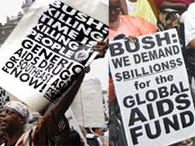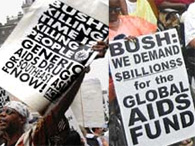Overall, the rate of new HIV diagnoses in 25 states increased by eight percent between 1999 and 2001, from 15,754 to 16,949, according Ronald O. Valdiserri, M.D., M.P.H., Deputy Director of CDC's National Centre for HIV, STD, and TB Prevention (NCHSTP).

Stop Global AIDS Now rally held in IN Washington DC in November 2002: protesters accuse President Bush of having "no plan ... except to starve domestic and international AIDS programs of funds in order to pay for an endless war."
The number of HIV diagnoses increased by 14 percent among men who have sex with men (MSM), from 6,614 to 7,521. The numbers also increased among heterosexuals by ten percent, from 4,973 to 5,468.
The data, collected from 25 states with longstanding HIV reporting, did not include states with high prevalence of HIV including New York and California, said Valdiserri. He warned that while important, the information is not representative of the entire nation.
"Medical care providers must play an active role in HIV prevention efforts if we are to achieve a reduction in the incidence of new HIV infections in the United States," Valdiserri said at the conference.
"Uninfected and undiagnosed patients need information about HIV risk and HIV testing, while patients diagnosed with HIV need counselling and support to help them protect their partners from infection."
Some MSM may believe that HIV is no longer a threat since the advent of strong and effective antiviral medications. The challenges of medication adherence, however, go far beyond simply popping a pill like a vitamin daily. For many taking antiviral medications, there are side effects ranging from nausea and diarrhoea to exhaustion and insomnia. There may also be dietary restrictions, and you can develop a drug resistant virus or may already have drug resistance that renders medications ineffective.
Increased rates of syphilis among MSM in New York, Los Angeles and Miami also have the CDC and other public health officials concerned, indicating an increase in risky sexual behaviour.

Stop Global AIDS Now rally held in IN Washington DC in November 2002: protesters accuse President Bush of having "no plan ... except to starve domestic and international AIDS programs of funds in order to pay for an endless war."
The majority of people with HIV are sexually active, according to findings initially presented at the 2002 International AIDS Conference in Barcelona.
There were 1,656 HIV-positive individuals interviewed for the CDC's multi-state Supplement to HIV/AIDS Surveillance (SHAS) Project. Interviews were conducted between January and October 2002. Sixty-nine percent of the participants reported being sexually active and 31 percent reported being abstinent. Many of these individuals were unaware of their partner's status and did not use condoms.
Healthcare providers should recommend testing to patients, Valdiserri said, noting that many of those who had been tested did so because of illness and not because their doctor or provider recommended it.
In fact, only six percent of more than 7,000 people who tested positive interviewed between 1997 and 2000 said they got tested because of a recommendation from their provider.
"There are many priorities competing for a physician's time and attention, but HIV counseling and testing need not be a time-consuming process for care givers," he said.
"Evidence shows that proper training can help providers smoothly incorporate HIV counseling into their practice."
